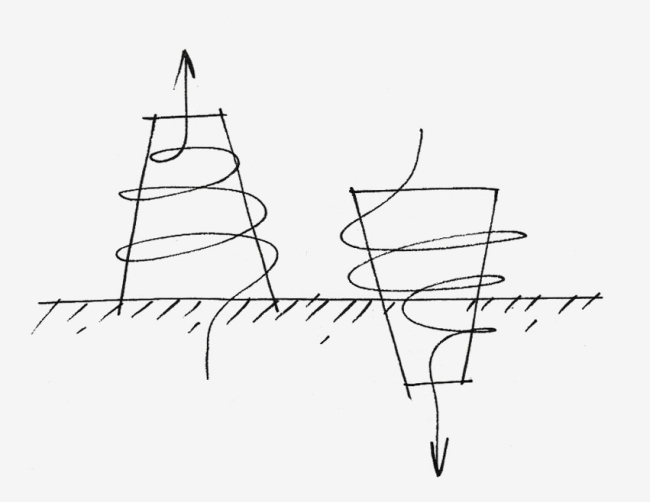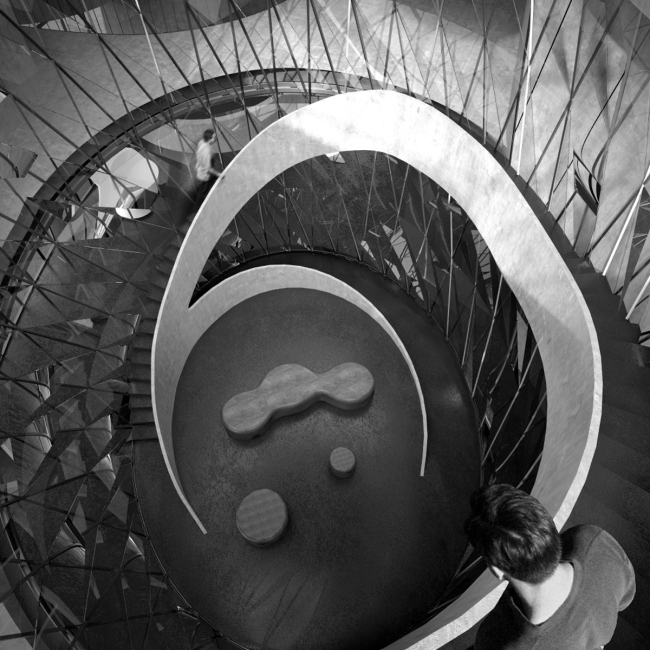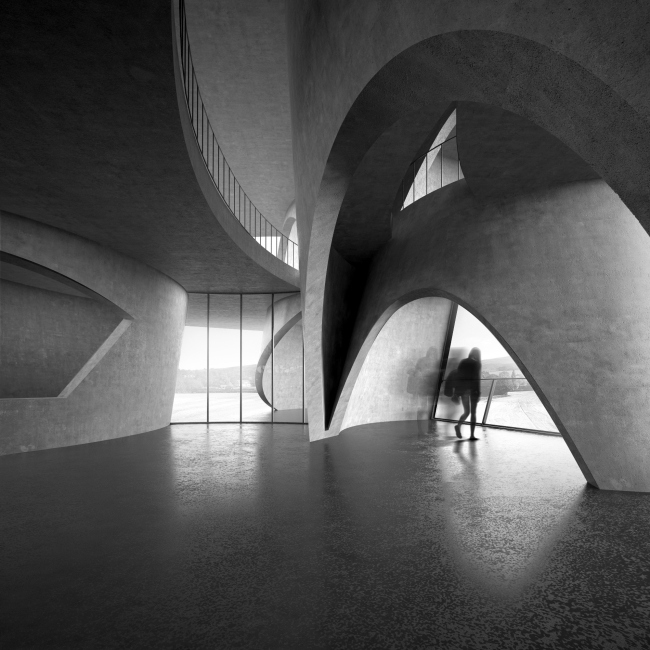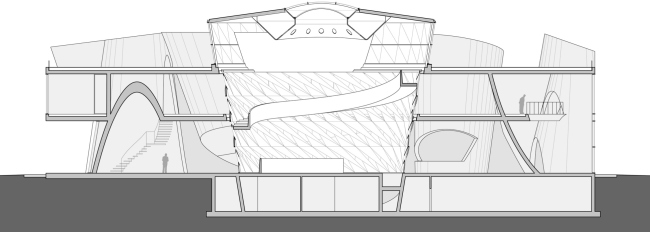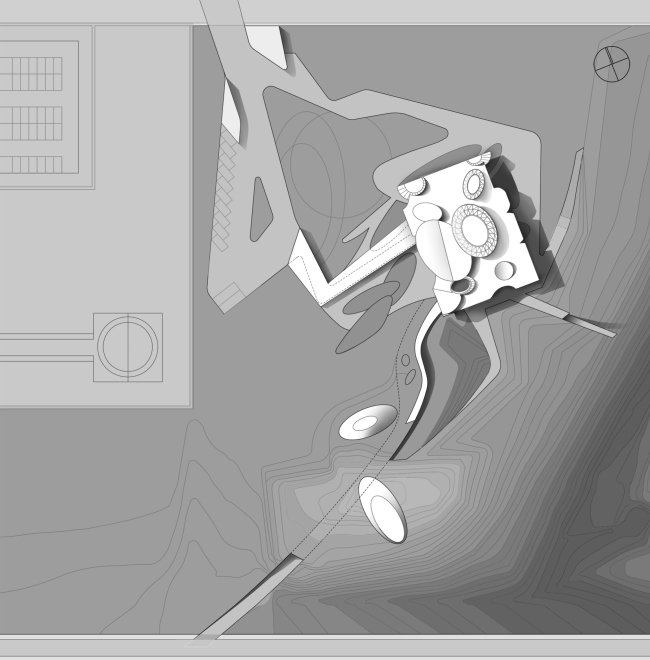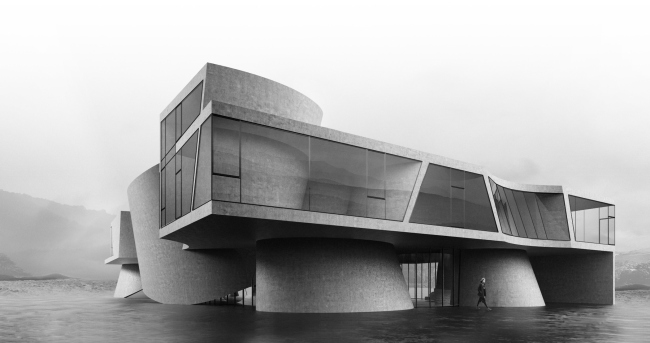|
For the contest project of expo and business center on Sakhalin Island, Levon Airapetov and Valerie Preobrazhenskaya proposed two options, the first one being a trailblazing experiment with the process of shape-forming where from one shape of a cone, repeated manifold, the architects build up a complex and unusual kind of space.
According to the
contest specifications, the expo and administrative center was to be situated
on the territory of a gas liquefaction plant located near the city of Yuzhno-Sakhalinsk. The
first version of the expo and business center is in fact a 3D experiment of
getting a complex space out of a simple shape taken as the starting point. This
basic theme and the shape-determining nucleus is the shape of the cone, i.e.,
the shape of the reindeer skin tent, so characteristic for these parts. The
idea of crossing the overturned cone with the non-overturned one occurred to a
young architect of the bureau Egor Legkov who discovered the conceptual
connection between the conic shape and the specialty of the plant. The conical
shape gave him the idea of an endless centripetal motion, the simplest way of
depicting the vortex that appears as a result of the drill rod spinning as well
as the image of an oil fountain springing from underground.
The role of such "fountain" is played by the atrium. Its overturned,
downward-pointed cone with its transparent walls made of dissected sharp glass
triangles, is located exactly in the middle of the building. It becomes the
conceptual and "image" nucleus of the building that connects all of
its floors with a spiral staircase that runs along the contour of the
"vortex". The crystal vortex is echoed by a multitude of cones of
smaller scales and sizes, the "regular" cones alternating with the
upturned ones, saturating the insides of the building and becoming in fact the
basic cell of its space structure, and even forming a 3D texture of sorts, a
particular kind of space that is "emotionally" charged, one that
bears the atmosphere that will be totally new to the visitors. All of the inner
walls of this building are either slanted or rounded. At some places they are
pierced so as to make way for passages and staircases - the openings get
parabolic arches on thin slanted legs that meet other arches, counter-slanted
to the opposite side. One gets a feeling of being inside a giant sponge with a
genetic code that is based not on bubbles but on cones.
To cut a long story short, apart from the floor and the ceiling, the building
does not a have a single straight surface inside of it, while on the layout it
looks like it is full of ovals. The ovals meet at various angles, at some
places overlapping and at some places bumping into one another. They house: the
major and the minor auditoriums, two small double-height atriums with trees and
spiral staircases, and even the restrooms. On the layout, the oval contours
show yet another peculiarity of the cones that form the building - most of them
are horizontally flattened.
At the same time, this stereometry, saturated with the dynamics of curved lines
and surfaces, is balanced off with straight lines and planes. The
"elephant's legs" of the cone-shaped volumes are bearing the
rectangular slab of the second floor. Unexpectedly rectangular, dominated by the
planes of the floor and the ceiling, with a glass belt running along its
perimeter, it has the appearance of the classic "Corbusier" sandwich
(floor layer, glass window layer, ceiling layer). The one exception is that the
surface of the facade running over the complex shape of the building becomes
the section plane for its complex stereometric insides - as if a piece of Dutch
cheese was cut at a random place, and at the cut it shows the truth of what it
has inside.
"The outside shape that functions as the cutting plane, gives the inside
shape a formal life, very often random and unexpected. This randomness,
however, is strictly "programmed" by the inner determination of the
connection between all the elements, all serving the given specifications - in
this particular case these are the expo halls, the offices, the meeting rooms,
and the technical premises - Valerie Preobrazhenskaya explains - The building
that we got as a result, stirred us to further exploration of how various
shapes can interact". None
None
None
None
None
None
None
None
None
None
None
None
None
None
None
None
None
None
|
